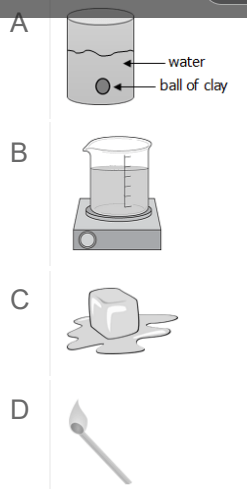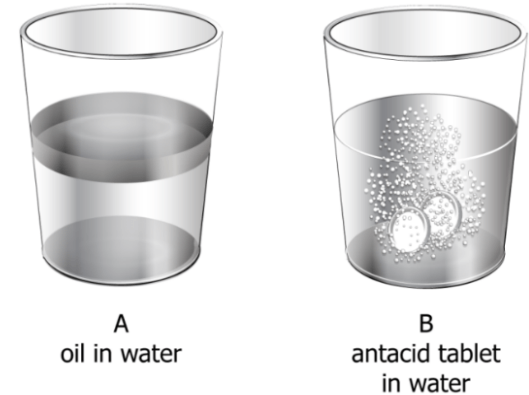In which situation is a chemical reaction not taking place?
A. salt dissolving in water
B. rusting of an old car in a junk yard
C. burning gasoline in a car
D. digestion of food in your body
What is salt dissolving in water?
Anna takes some apples and makes the changes as described in the list.

Which process(es) will lead to a chemical change only?
A. 1 only
B. 3 only
C. 2 and 4
D. 1 and 2
What is 3 only?
Which activity will most likely produce a new substance with properties different from the original materials?
A. mixing chocolate syrup into a glass of milk
B. breaking a window with a rock
C. leaving a metal bike outside in the rain
D. mixing water and crushed rock
What is leaving a metal bike outside in the rain?
Ron observed a person making a campfire. He made a list of three things he observed.

During which observation(s) was Ron observing a physical change?
A. observation 1
B. observation 3
C. observation 1 and 3
D. observation 2 and 3
What is observation 1?
Which image represents a chemical change?

What is choice D?
Which is the best example of a chemical change?
A. bonfire
B. chopping wood
C. crushing a can
D. ice melting
What is a bonfire?
A student watches a burning candle and writes down her observations. Which observation represents a chemical change?
A. The candle wax melts.
B. The size of the candle reduces.
C. The candle wick burns with a flickering flame.
D. The hot wax flows down the candle and later hardens.
What is the candle wick burns with a flickering flame?
Arnold makes some changes to a piece of paper.
Which change produces a new material?
A. tearing a piece of paper
B. folding a piece of paper
C. cutting a piece of paper
D. burning a piece of paper
What is burning a piece of paper?
A student observes a few changes and lists her observations in the table below.

Which observations are correctly categorized?
A. 1 and 3
B. 3 and 4
C. 1, 2, and 3
D. 1, 3, and 4
What is 1 and 3?
In science class, Ashley is learning about physical and chemical changes. She writes some possible examples of each in her science journal.

Which observation(s) is (are) identified with the correct type of change?
A. 1 only
B. 4 only
C. 1 and 3
D. 2 and 3
What are 1 and 3?
____________ can be observed without changing matter.
A. Physical Properties
B. Chemical Properties
C. Political Properties
D. Chemical Changes
What are physical properties?
Terry is performing experiments using paper.

Which experiment resulted in a chemical change?
A. drawn on with crayon
B. burned
C. shredded
D. placed in water
What is burned?
A student makes a list of activities she observes.

Which activity(ies) represent(s) a physical change, and why?
A. 1 only; there is a change of shape
B. 3 only; there is a change of state
C. 2 and 3 only; new substances are formed
D. 1, 2, and 3; the substances retain their original properties
What is 1, 2, and 3; the substances retain their original properties?
Which activity is an example of a physical change?
A. An ice cube melts into liquid water when heated.
B. A piece of wood produces heat when it is burned.
C. An apple turns brown when it is exposed to air.
D. A metal chain rusts when left outside.
When an ice cube melts into liquid water when heated?
Which of the following would be considered an indication that a physical change has taken place?
A. Bubbles or a gas are created.
B. A new substance, or precipitate, has formed.
C. The substance changes from a solid to a liquid.
D. An unexpected color change occurs.
What is the substance changes from a solid to a liquid?
The diagram shows what happens when oil and an antacid tablet are added to a glass of water.

Which statement is true?
A. Both glasses A and B show physical changes.
B. Both glasses A and B show chemical changes.
C. Glass A shows a physical change, and glass B shows a chemical change.
D. Glass A shows a chemical change, and glass B shows a physical change.
What is glass A shows a physical change, and glass B shows a chemical change?
Which pair of substances when mixed together form a new substance that has different properties than the orignal substance?
A. salt + water
B. sugar + water
C. vinegar + baking soda
D. food coloring + milk
What is vinegar + baking soda?
A student makes a list of changes observed.

Which takes correctly classifies the changes observed?
A. physical change - 1 and 2; chemical change - 3 and 4
B. physical change - 1 and 4; chemical change - 2 and 3
C. physical change - 1 and 3; chemical change - 2 and 4
D. physical change - 3 and 4; chemical change - 1 and 2
What is physical change - 1 and 4; chemical change - 2 and 3?
A boy holds an ice cream bar outside in the hot Sun, causing it to begin to melt. The boy quickly puts the entire melted ice cream bar in a paper cup and places it in the freezer to refreeze.
Which statement describes the weight of the ice cream bar?
A. The ice cream bar weighed more before it melted.
B. The ice cream bar weighed less before it melted.
C. The ice cream bar weighed more after it was refrozen.
D. The ice cream bar weighed the same after it was refrozen.
What is the ice cream bar weighed the same after it was refrozen?
Which of the following substances are created as a result of a chemical change?
A. Compound
B. Element
C. Mixture
D. Solution
What is a compound?
A student mixes two clear liquids and finds that they turn blue when combined. What type of change did the student observe?
A. change in color
B. change in shape
C. change in size
D. change in texture
What is change in color?
A student adds a solid to a liquid. What would indicate that a chemical change has occurred?
A. The solid produces gas bubbles.
B. The solid expands.
C. The solid floats to the top.
D. The solid sinks to the bottom.
What is the solid produces gas bubbles?
During an activity, Angelina labels two bowls A and B. She adds water in bowl A and a tablespoon of baking soda in bowl B. Then she adds a tablespoon of lemon juice to both bowls. Angelina observesthat bubbles are formed in bowl B but not in bowl A.
What type of change occurred in bowls A and B?
A. bowl A: physical change; bowl B: physical change
B. bowl A: chemical change; bowl B: chemical change
C. bowl A: physical change; bowl B: chemical change
D. bowl A: chemical change; bowl B: physical change
What is bowl A: physical change; bowl B: chemical change?
Regina is baking a cake. She prepares the batter by adding500 g of flour, 200 g of butter, and 300 g of sugar in a bowl.
What is the mass of the batter in the bowl?
A. 500 g
B. 700 g
C. 800 g
D. 1,000 g
What is 1,000 g?
Select all the scenarios that would result in a physical change.
A. A chocolate candy bar was left in the sun and melted.
B. Cake batter was placed in the oven and baked into a cake.
C. Hydrogen and oxygen atoms combined to form a water molecule.
D. Salt and water were mixed to make salt water.
E. A piece of paper was cut into 5 pieces.
F. A candle wick burned for 3 hours.
G. Lemon juice, water, and sugar were mixed to make lemonade.
H. Milk and vinegar were combined and curds formed.
What are A, D, E, and G?